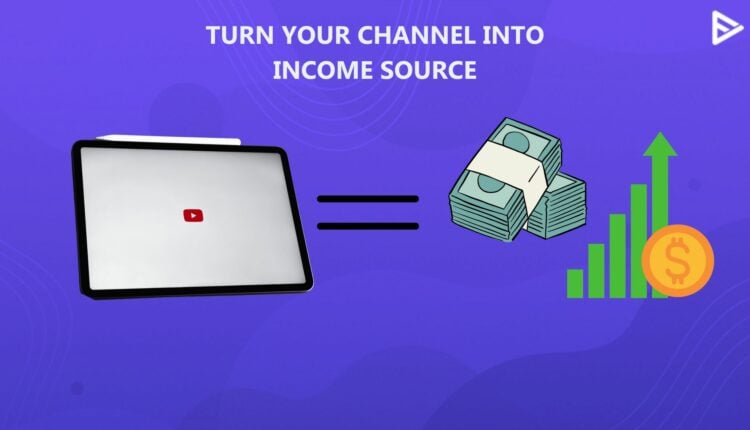Every creator, whether experienced or a beginner, looks for multiple ways to make money on YouTube. Many creators have found success on YouTube by producing videos that entertain and educate their target audience. With the rising competition, there are also equally powerful opportunities that can help you steadily grow your channel and open doors to make money on YouTube. Let’s dive into further details.
Best Ways To Make Money On YouTube
Here are the best practices to earn money on YouTube:
YouTube Partner Program
YouTube Partner Program is the core foundation for making money on YouTube. If you’re not a part of the YPP, you won’t be eligible to earn monetary benefits from ads and premium subscriptions from YouTube. Here are the conditions you need to follow to get started with the YouTube Partner Program:
- Before applying for YPP, make sure your channel follows YouTube’s terms and policies
- You must have a minimum of 500 subscribers and over 3000 hours of watch time in the past 12 months. Alternatively, your channel must have had 3 million views on YouTube shorts in the last 90 days.
- Your Google account needs to have a 2-step verification.
- Once you’re eligible, you can sign the YPP terms and conditions.
- Create an AdSense account.
- After signing YPP’s terms and conditions, your account will be reviewed.
- If your account is approved, you can earn monetary benefits from ad campaigns and premium subscriptions. You can re-apply after 30 days if not approved.
YouTube Affiliate Marketing
One way to earn money is to promote videos on YouTube through Google ads; another is YouTube affiliate marketing. It’s simple: You add third-party links in your video description, your viewers click on the links to buy products, and you earn a commission in return.
You can also share promo codes and links for the products you review. If the buyer purchases the products from the link you share, you will earn monetary benefits in return.
We at Veefly help you to earn decent revenue through affiliate marketing.
YouTube Sponsorships
YouTube introduced the new tick icon beside your Channel name. You must also have noticed a ‘Join’ or ‘Sponsor’ option beside the ‘Subscribe’ icon. This option allows your subscribers to pay a monthly fee of $5. In return, you need to provide them with exclusive content. They can also earn discounts on tickets for events and training programs.
To earn YouTube Sponsorship, you need to have 30K subscribers, and you should be a part of the YouTube Partner Program. You can always explore buying YouTube subscribers to accelerate your pace of gaining subscribers.
What Other Ways Do YouTubers Make Money?
YPP and brand sponsorships are the primary sources of money earned on YouTube. However, there are some other ways to help you make money quickly on YouTube, which many creators aren’t aware of.

Sell Products Or Merchandise
The first way to make money through YouTube is by selling your products and merchandise. You can create your brand’s product and sell it on the platform. These products include t-shirts, coffee mugs, or tote bags. Merchandise increases your exposure by putting your brand online and deepens the relationship between your fans and your business.
Crowdfund Projects
If you think your ideas are worthy of execution, you should consider crowdfunding. You can pitch your ideas to your crowdfunding community and audience to sell your project and earn money.
Earn Through Fan Funding
Similar to crowdfunding, you can also earn money through fan funding. Audiences are inclined to support creators, offering good content across the platform. Through the fan funding feature, viewers can directly help you grow your channel with tips and monthly payments. Your fans can support your growth during live streams by buying super chat, stickers, and thanks messages.
Get Your Content Licensed
Licensing your content helps you reach a larger audience while earning money. So, if you believe you have created a viral video with mass appeal, you can license your content in exchange for money. This lets you gain popularity as well.
Work with Brands As Influencers
Influencers are known to have won the loyalty of their fans, which is why brands collaborate with influencers to expand their reach and awareness. However, we highly recommend you partner with brands whose products or services you like or believe in. Your loyal fans can easily spot the difference and may even stop trusting you if they feel you’ve collaborated just for financial gain.
Ways To Make Money On YouTube Without Making Videos
The ways of earning on YouTube are similar to what we have mentioned above. However, creating videos on YouTube is not the only way to make money on the world’s largest video-sharing platform. Besides, if you feel shy about appearing in front of the camera and prefer to look for ways to make money on YouTube without making videos, here are some topics you must explore when creating videos.
- Meditation
- Record ASMR audio
- Create Sound Effects
- Podcast
- Stream Video Games
However, you must remember that your video descriptions and titles must be enticing enough to grab your viewer’s attention. An AI YouTube Title generator can help you craft eye-catching titles within a few seconds, thus saving you valuable time spent otherwise in brainstorming. Besides, an AI YouTube description generator can assist you in writing compelling SEO-friendly descriptions for your YouTube videos.
Conclusion
We are sure these YT programs will help you make money on YouTube. However, remember that creating a steady source of income from YouTube is time-consuming. But to start earning, your channel needs to meet the requirements of the YPP. Also, you can consider promoting your videos through YT promotion services and buy YouTube views that help you reach your target audience faster through proven promotional strategies.
Frequently Asked Questions
Q1. Can YouTube Shorts Be Monetized?
YouTube allows you to monetize your shorts once you have 500 subscribers on your channel. Yes. Since the monetization requirement update is launched, you need to get 500 subscribers and 3 million valid short views in 90 days to start monetizing.
Q2. Does YouTube Pay You Monthly?
YouTubers with a membership to YPP get paid every month between the 21st and 26th through AdSense. However, you must reach the $100 minimum payment threshold to get paid monthly. If you don’t reach the threshold, the earnings roll over to the next month.
Q3. How Much Does YouTube Pay?
The amount of money YouTube pays creators depends on many factors, including how many views a video receives. The average pay a YouTuber gets per ad view is $0.018. However, the range can fluctuate between $0.10 and $0.30 per ad view.
Q4. How Many Views Do You Need To Get Paid By YouTube?
Generally, YouTubers need to reach 1000 views per video to earn money on the platform. But this is when you are a member of the YouTube partner program. Usually, you need to generate 1,00,000 YouTube views per video to get paid by the platform.
Q5. How Does The YouTube Ad Revenue Model Work?
Many novice YouTubers ask how they can earn money from YouTube. Ad-free is the money made through the advertisements on your revenue model that considers your video’s projected ad impressions and monetized ad playbacks. For example, let’s say your video has 10 views, with 8 views containing ads. In this case, the estimated monetized playback would be 8.
Q6. Can Creators Make Money on YouTube Through Sponsored Content?
Sponsorship is one of the many ways content creators earn money on YouTube. Partnering with brands that share your values can benefit YouTubers and brands equally. It allows creators to earn money and helps brands spread awareness and generate traffic and leads for their products and services through the creator’s following.


